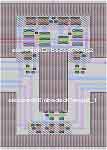
Chemiresistors
- Related Links
The chemiresistors have in common a fundamental electrical output quantity (resistance) that is related to the chemical/biological input (concentration). The manner in which analyte concentration is converted to a resistance change varies with the type of material used. For example, composite polymer chemiresistors (a combination of insulating, chemically sensitive polymer and an inactive conductive agent) swell in the presence of certain analytes, typically causing an increase in resistance. Metal-oxide sensors, in contrast, are reduced by analytes, forcing electrons to be re-injected into the bulk resistor, resulting in a decrease in resistance.
All of the basic models provided in the links to these pages generate a resistance output and take the following inputs:
Technology type: reflects the type of sensing material
Material type: functionalized material within technology type
Analyte: choice of analytes is specific to every dataset(links above)
Concentration: in ppm
The syntax for accessing the basic model using the function file
chemiresistor.m
is as follows:
output =
chemiresistor (technology, material type, analyte, concentration)
The technology type is described in the function chemiresistor(located in the file chemiresistor.m); material type and analyte are described in the
corresponding
.mat files that store specific experimental data for these sensing layer/analyte combinations.
An example used to determine the response of a composite polymer chemiresistor coated with material poly1a at a
concentration of 100 ppm, in response to benzene, is:
r = chemiresistor ('comp_polymer', 'poly1a', 'benzene', 100)